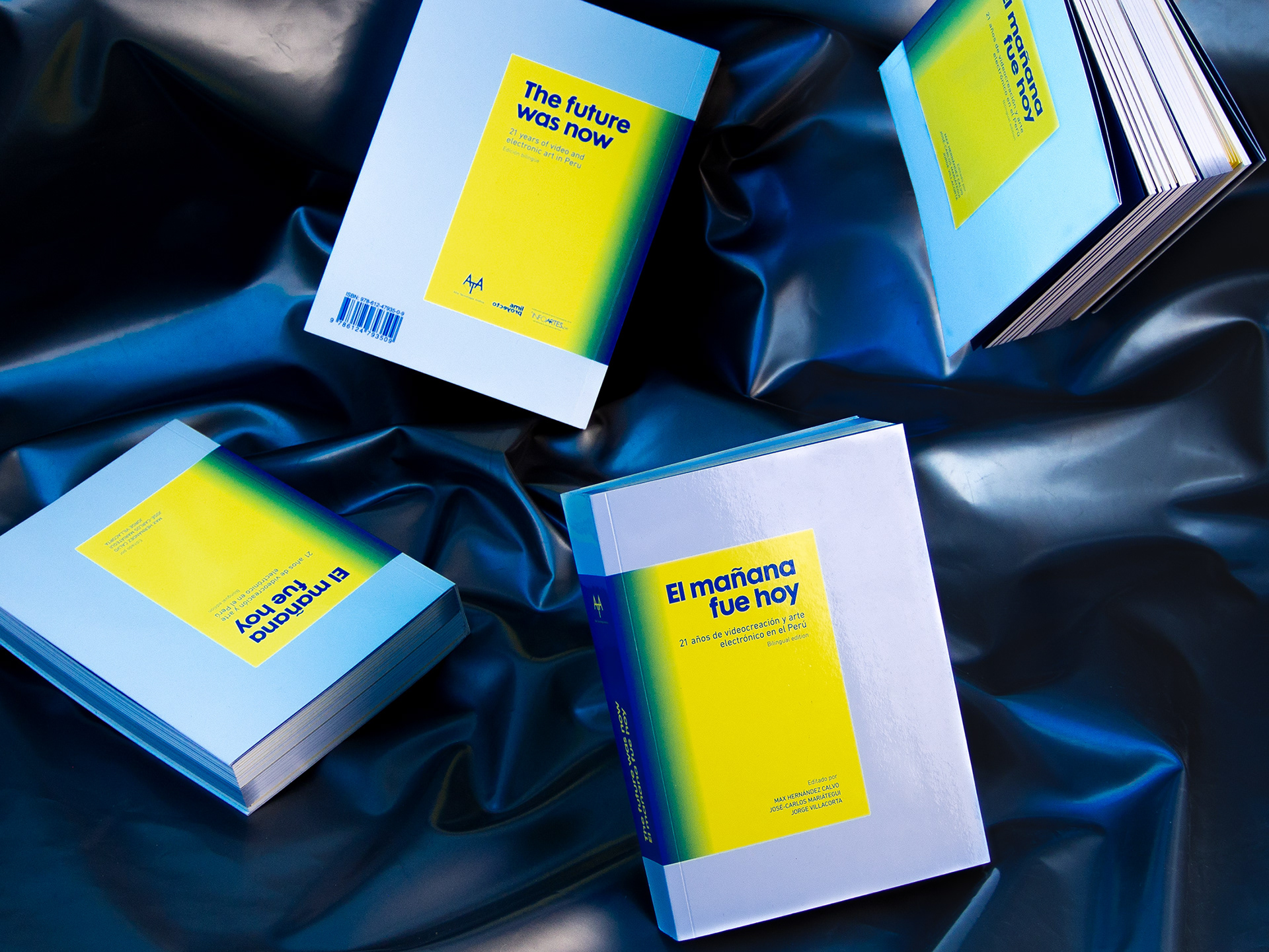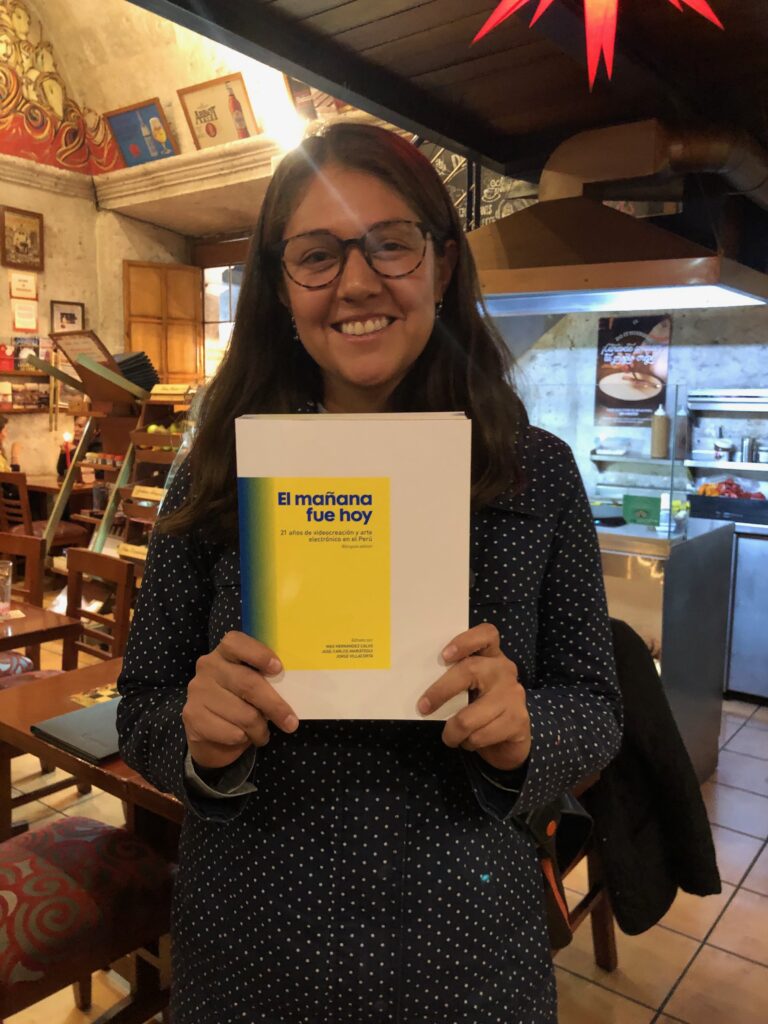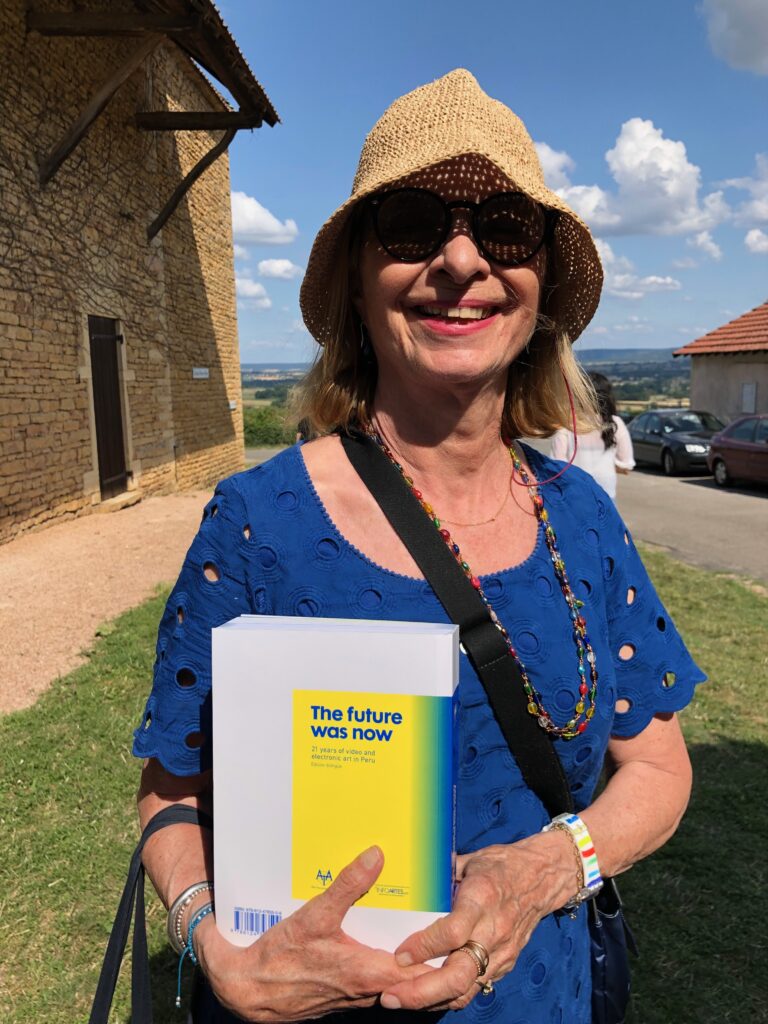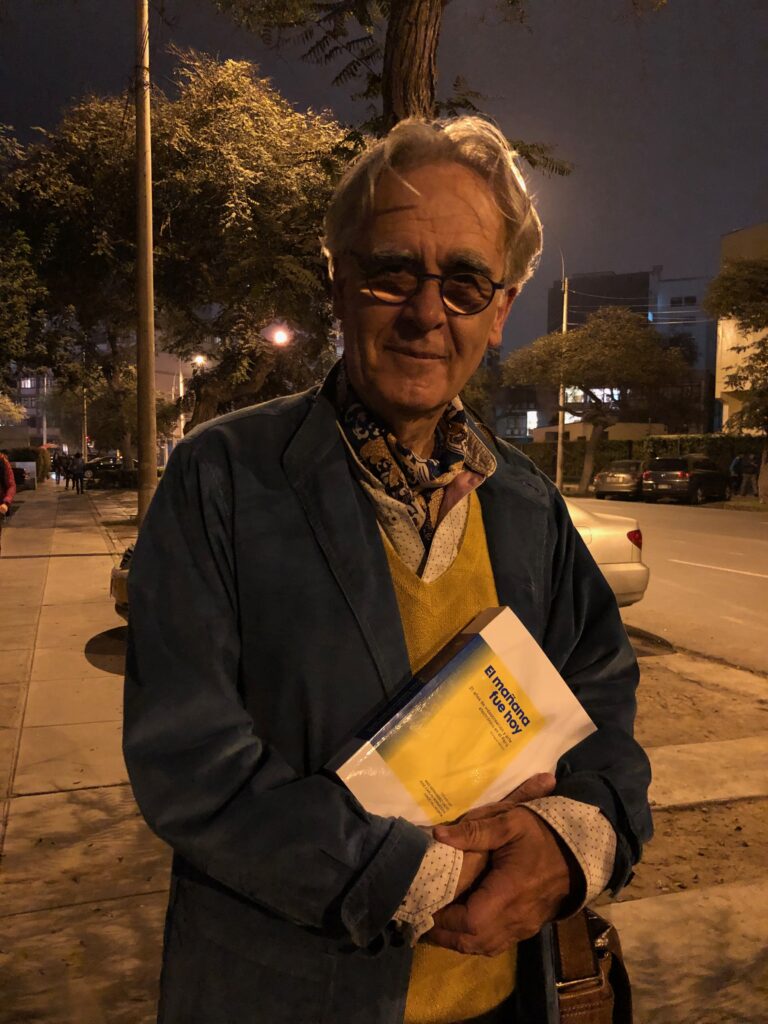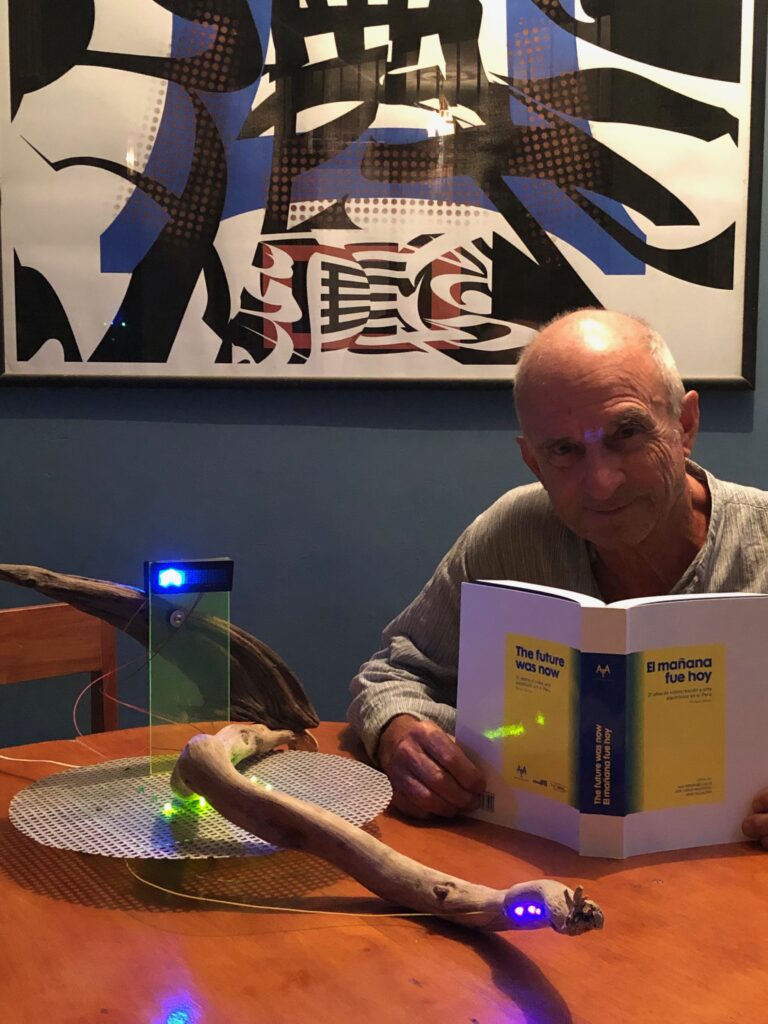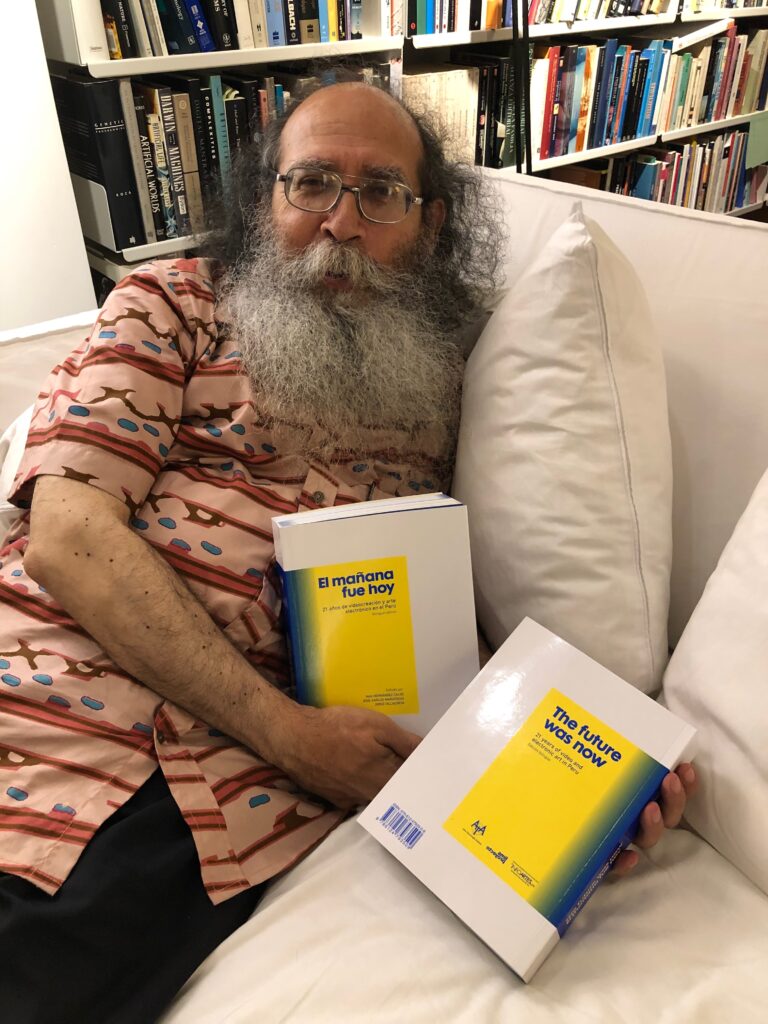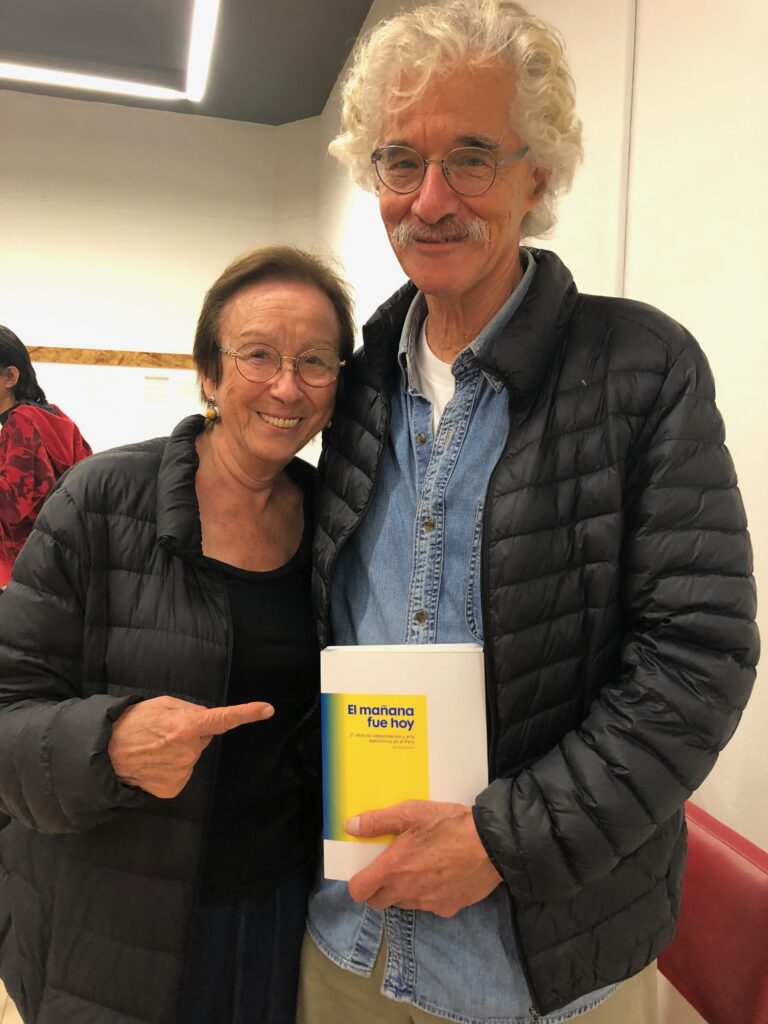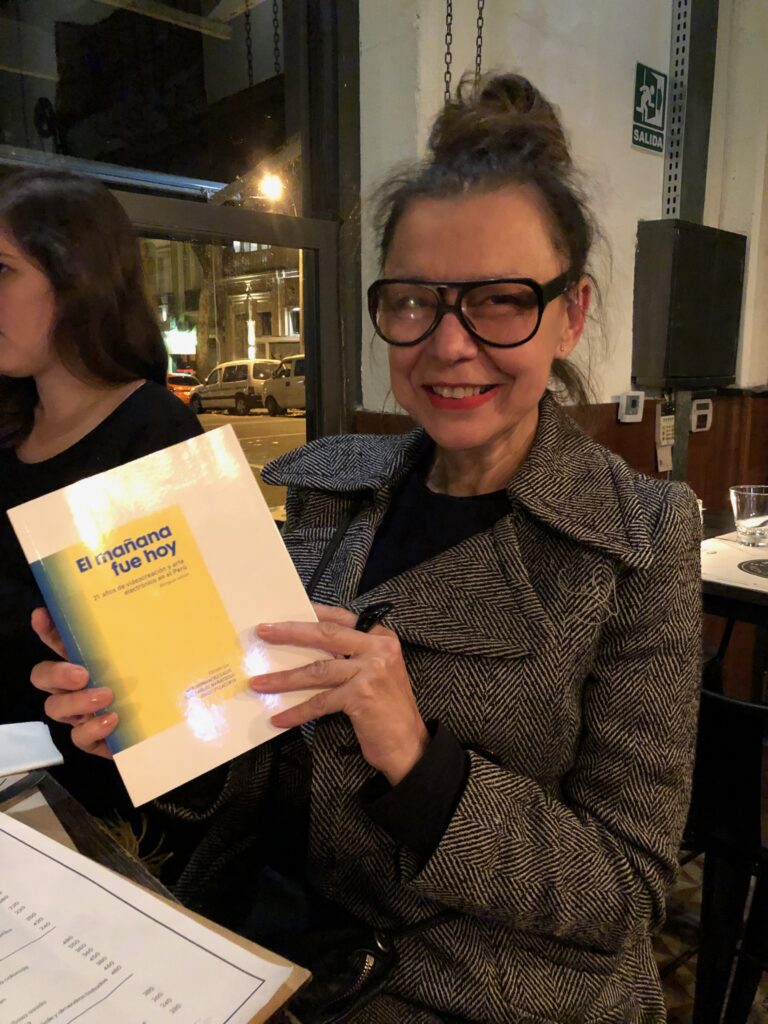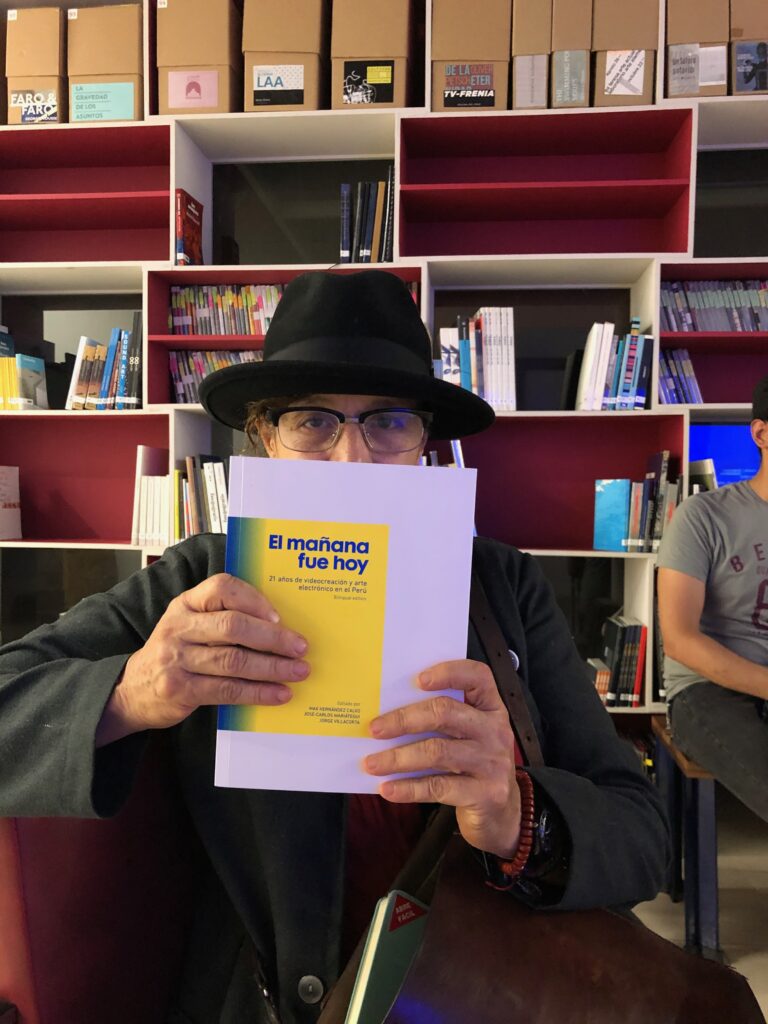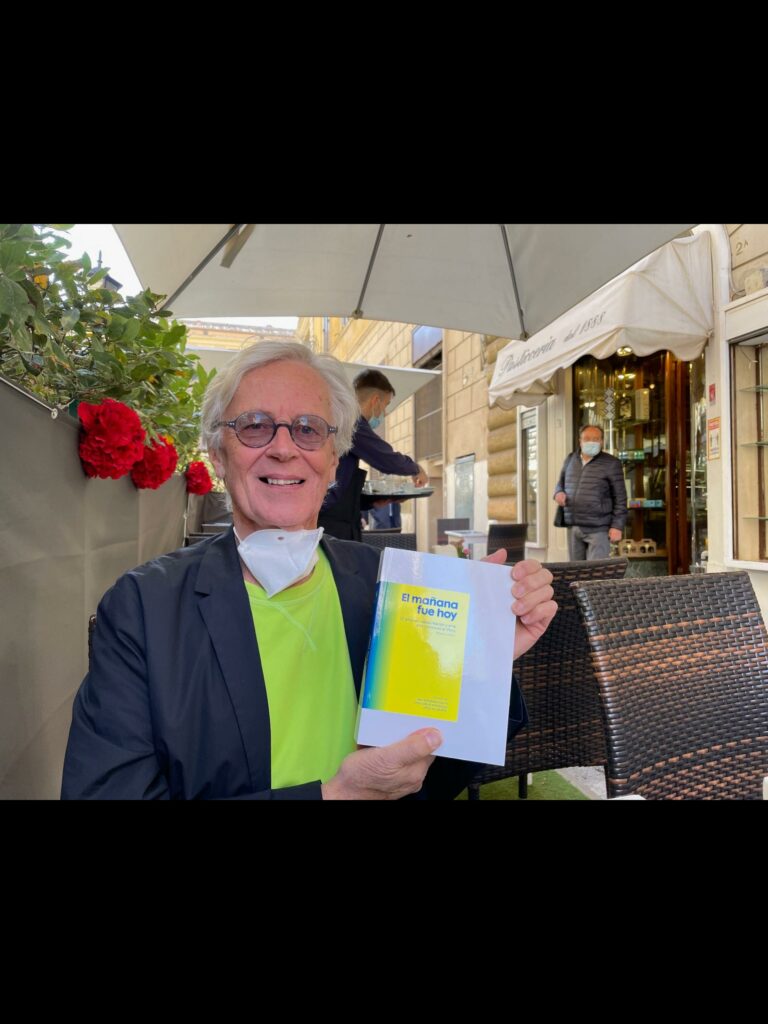EL MAÑANA FUE HOY. 21 AÑOS DE VIDEOCREACIÓN Y ARTE ELECTRÓNICO EN EL PERÚ
EL MAÑANA FUE HOY – Libre Acceso !! / THE FUTURE WAS NOW – Open Access !!
Nuestro libro «El mañana fue hoy: 21 años de videocreación y arte electrónico en el Perú» en edición bilingüe se encuentra disponible para su libre revisión en nuestra web, así como para descarga libre en el siguiente enlace:
Our book ‘The Future Was Now. 21 Years of Video Art and Electronic art in Peru’ in bilingual edition is available Open Access on our website, as well as a free download at the following link:
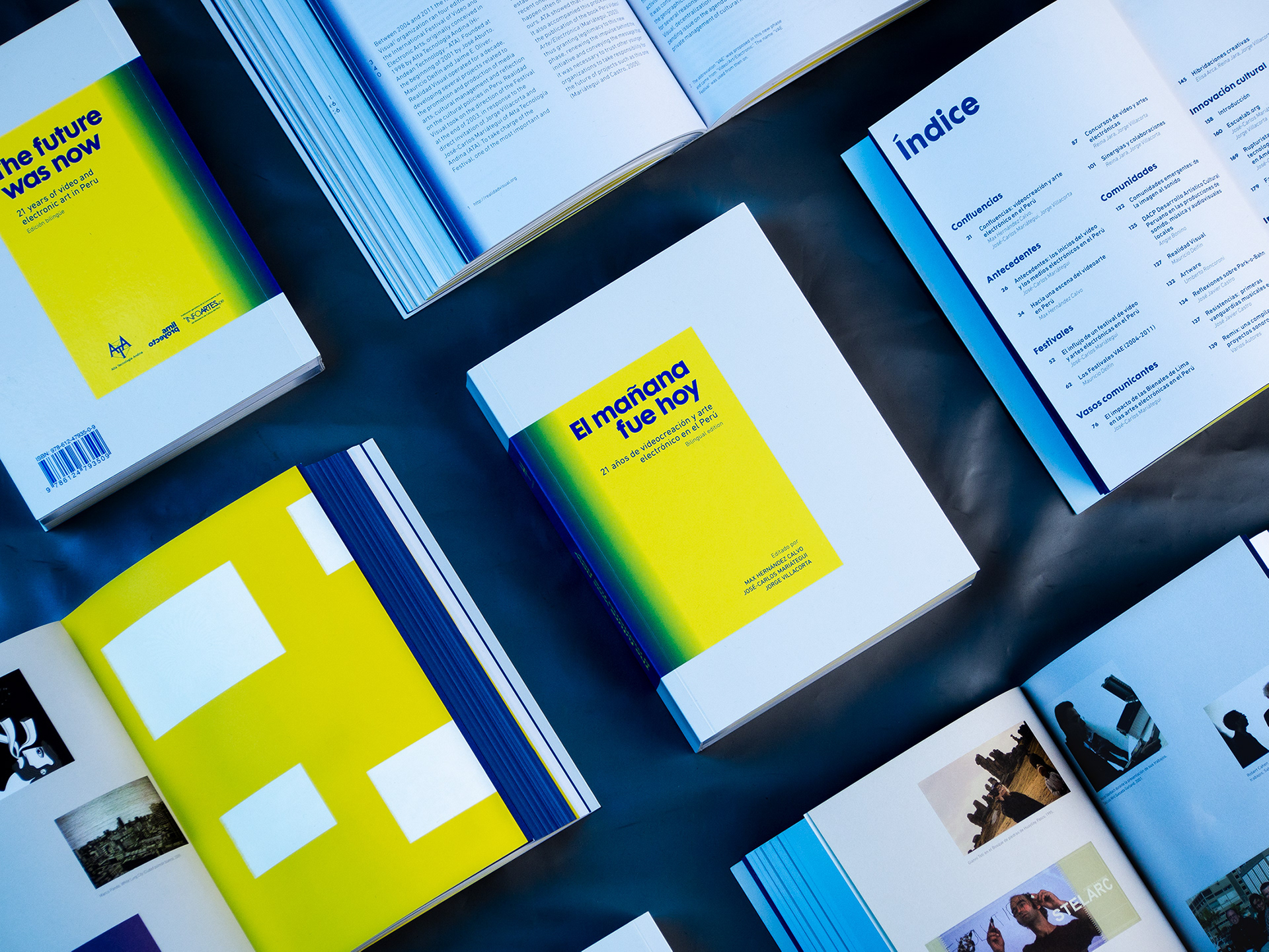
[English follows]
Alta Tecnología Andina – ATA se complace en anunciar la publicación de El mañana fue hoy. 21 años de videocreación y arte electrónico en el Perú, una compilación de ensayos sobre las últimas dos décadas de videoarte y arte electrónico peruanos, editado por Max Hernández-Calvo, José-Carlos Mariátegui y Jorge Villacorta.
Esta edición bilingüe en inglés y español reúne una serie de ensayos y reflexiones sobre el videoarte en Perú durante las dos primeras décadas del siglo XXI, y el impacto general del arte de nuevos medios en el paisaje cultural, así como sus conexiones con otras disciplinas y con otras iniciativas regionales e internacionales. El panorama que presenta este importante esfuerzo de investigación, examina la rica y compleja trayectoria del desarrollo del video y el arte electrónico recientes en el Perú, desde sus inicios experimentales y precarios hasta su relevancia actual en la escena del arte contemporáneo local, a través de una fuerte representación de galerías y museos, y redes fluidas de distribución. En esta historia, tal como se examina en los ensayos del libro, el surgimiento de los festivales de video y arte electrónico en Perú es un momento clave en el establecimiento de una comunidad local de videoarte, que atrajo a artistas de diversos orígenes y formación. Al trazar los primeros años de los festivales, El mañana fue hoy destaca las contribuciones estéticas de una serie de artistas que, durante muchos años, fueron personajes de culto, aunque desconocidos. Pero el libro también reconoce el papel vital desempeñado por diversos proyectos y organizaciones que dieron forma al paisaje de los nuevos medios en Perú a través de sus múltiples esfuerzos. En ese sentido, como lo sugiere el título, ese nuevo día estético que se buscó durante la última década del siglo XX, efectivamente llegó a través de los esfuerzos combinados de muchos actores de la época, incluso si no se logró reconocer en ese momento. Otros temas que el libro aborda son el lanzamiento de concursos de videoarte, iniciativas regionales centradas en el medio, así como el desarrollo de prácticas y lenguajes específicos, como cine digital, animación, video- instalación y video-performance. El mañana fue hoy también incluye una línea de tiempo de la aparición del video / TV y el arte de los nuevos medios en Perú, desde 1939 hasta 2015, que ofrece un panorama claro y conciso de esta historia.
La publicación ha sido posible gracias al apoyo del Sistema de Información de las Artes en el Perú (INFOARTES) de la Dirección de Artes del Ministerio de Cultura del Perú y del Proyectoamil.
Sobre El mañana fue hoy algunos eminentes investigadores de los nuevos medios han señalado:
“Hoy la vibrante escena del video y las artes electrónicas de Lima y Perú es descrita y analizada por las personas que la presenciaron y la hicieron posible. Este fascinante libro describe un panorama lleno de inventos, no solo de video, animación, sonido y obras de arte interactivo, sino también de las infraestructuras y colaboraciones que surgieron para hacer posible su creación […] acciones de increíble originalidad cuyo valor se extiende a lo largo de décadas y más allá de las fronteras del Perú. Un compendio inestimable sobre cómo inventar un medio y una escena relevante”.
Sean Cubitt
Professor of Film and Television, Goldsmiths, Londres
Editor de la Serie Leonardo Books en MIT Press
“La investigación realizada por Hernández, Mariátegui y Villacorta es un ejemplo jubiloso que ilumina el video y arte electrónico de las últimas décadas en América Latina […] revela una gama de artistas diversos e intrigantes, que apuntan a posibilidades que aún están por desarrollarse. El libro es la mejor prueba de que todavía hay mucho por investigar sobre el arte electrónico y su reciente y rica historia.”
Solange Farkas
Fundadora y Directora de Videobrasil
El mañana fue hoy salda con creces la deuda pendiente de producir una historia crítica y analítica de las artes electrónicas en diálogo y a tono con publicaciones de referencia que se han venido desarrollando en América Latina cumplimentando esta tarea ofreciendo un amplio panorama y fundamentado estudio del derrotero de las artes tecnológicas en el Perú. […] señala un partido conceptual e ideológico diverso al de las modas corporativas alrededor del arte y de las historias de la imagen en movimiento.
Jorge La Ferla
Profesor Titular de la Universidad de Buenos Aires
Nota de los Editores: Hemos recibido el comunicado elaborado por el Colectivo Aloardi, donde se señalan y realizan dos correcciones en relación a los contenidos de la publicación «El Mañana fue hoy. 21 años de videocreación y arte electrónico en el Perú», el comunicado se puede leer en el siguiente link: http://ata.org.pe/2020/07/15/comunicado-colectivo-aloardi/
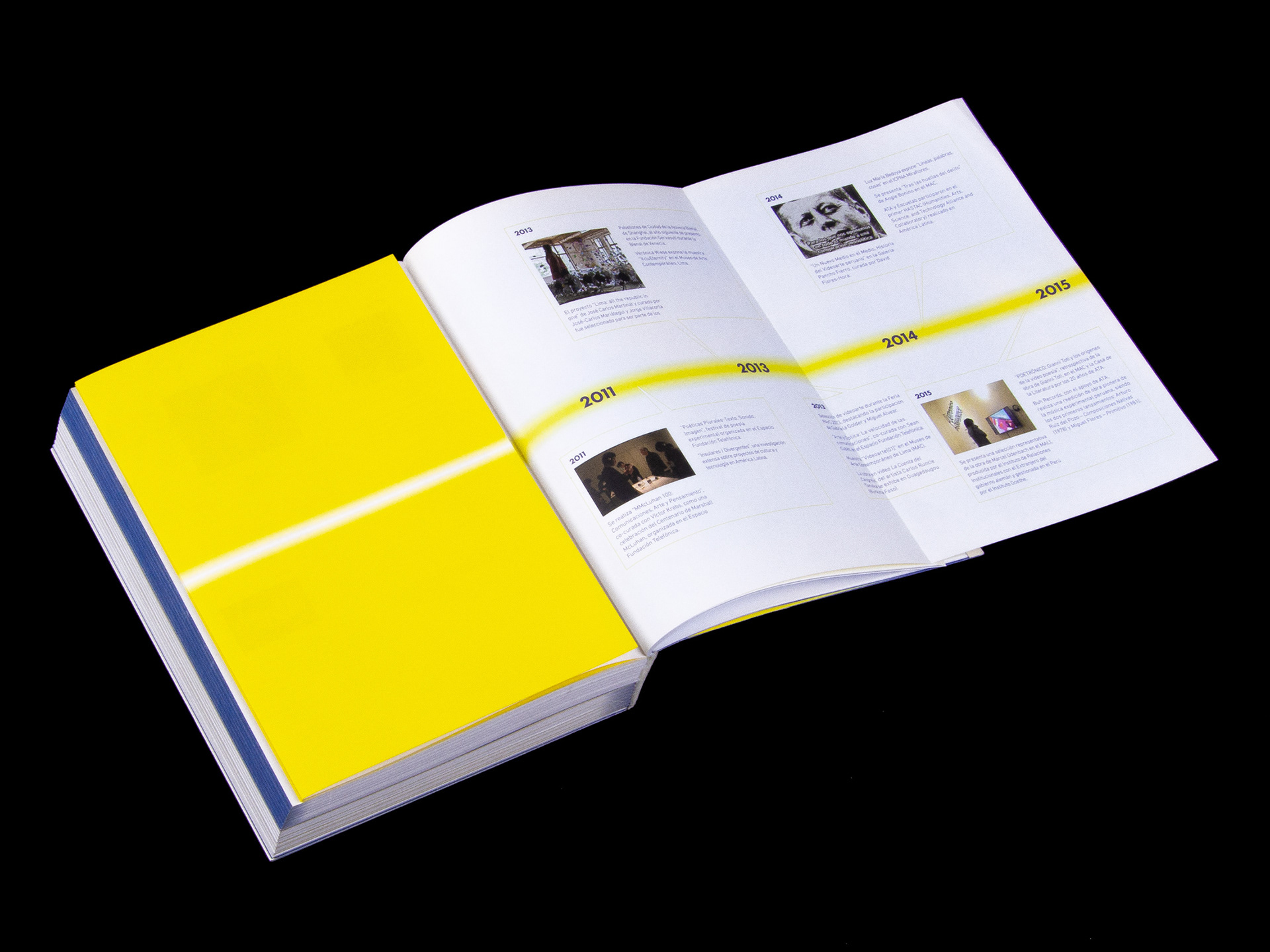
The Future Was Now. 21 Years of Video Art and Electronic art in Peru
Alta Tecnología Andina – ATA is pleased to announce the publication of The Future Was Now. 21 Years of Video Art and Electronic art in Peru, a compilation of essays on the past two decades of Peruvian video and electronic art, edited by Max Hernández-Calvo, José-Carlos Mariátegui and Jorge Villacorta.
This bilingual edition in English and Spanish gathers a number of essays and reflections on video art in Peru during the first two decades of the 21st century, and the general impact of new media art on the cultural landscape, as well its connections with other disciplines, and with other regional and international initiatives. The overview that this important research effort presents, examines the rich and complex trajectory of the development of recent video and electronic art in Peru, from its experimental and precarious beginnings to its current relevance in the local contemporary art scene, through strong gallery and museum representation, and fluid distribution networks.
In this history, as examined by the book’s essays, the emergence of the seminal Video and electronic art festivals in Peru is a key moment in the establishment of a local video-arts community, which attracted artists from diverse backgrounds and training. By charting the early years of the festivals, The Future Was Now highlights the aesthetic contributions of a number of artists who, for many years cultish yet obscure figures. But the book also acknowledges the vital role played by the various projects and organizations that shaped the new media landscape in Peru through their multiple efforts. In that regard, as the title suggests, that “aesthetic future” that was sought during the last decade of the 20th century, did indeed happen through the combined efforts of many actors of the time, even if unacknowledged at the time.
Other issues the book engages are the launching of video art competitions, regional initiatives focused on the medium, as well as the development of specific practices and languages, such as digital cinema, animation, videoinstallation and videoperformance.
The Future Was Now also includes a timeline of the emergence of video / TV, and new media art in Peru, from 1939 to 2015, offering a clear and concise panorama of this history.
Contributors include Mauricio Delfín, Reina Jara, Angie Bonino, Umberto Roncoroni, José Javier Castro, Elisa Arca, Enrique Mayorga, Beno Juárez, Lydia Haustein, Kathleen Forde, Sandra Lischi and Vera Tyuleneva, among others.
The publication has been possible thanks to the support of the Information System of the Arts in Peru (INFOARTES) of the Arts Directorate of the Ministry of Culture of Peru and of Proyectoamil.
Praises for The Future Was Now
The research conducted by Max, Jose-Carlos and Jorge is a joyful example on illuminating video and electronic art over the last decades in Latin America. Mapping projects and organizations that have shaped the landscape of new media in Peru, “The Future was now” reveals a range of diverse and intriguing artists, pointing possibilities that are still to be developed. The book is the best prove that there is still so much to investigate on electronic art and its recent and rich history.
Solange Farkas
Founder – Director
Associação Cultural Videobrasil
Now the vibrant video and electronic arts scene of Lima and Peru comes into focus, described and analysed by the people who were there, made it and made it possible. This entrancing book describes a scene bubbling with invention, not just of video, animation, sound and interactive artworks, but of the infrastructures and collaborations that had to be created to make it possible to make them. These networks and associations are artworks in themselves, experiments and performances of incredible originality whose value extends over decades and across territories far beyond Peru’s borders. An invaluable primer on how to invent a medium and a scene where it matters.
Sean Cubitt
Professor of Film and Television at Goldsmiths, University of London
Series editor for Leonardo Books at MIT Press
By proposing a broad and well-founded study of the course of the technological arts in Peru, The Future Was Now greatly contributes to produce a critical and analytical history of the electronic arts which is in dialogue and in tune with other publications that have been developed in Latin America. […] points out a conceptual and ideological party different from the corporate trends around art and the stories on the moving image.
Jorge La Ferla
Professor of Film and Media at Universidad de Buenos Aires
Editors’ Note: We have received the statement made by Collective Aloardi, where two corrections are indicated and made in relation to the contents of the publication “The Future Was Now. 21 Years of Video Art and Electronic art in Peru ”. The statement can be read at the following link: http://ata.org.pe/2020/07/22/communique-colectivo-aloardi/
REGISTRO FOTOGRÁFICO:
Puede adquirir la publicación en las siguientes librerías / Points of sale:
Lima, Perú
MALI – Museo de Arte de Lima
Paseo Colón 125, Parque de la Exposición
Lima 15046
Tel: (+51-1) 204 0000
Email: informes@mali.pe
https://mali.pe
Adquiérelo de manera online aquí
Librería Sur
Av. Pardo y Aliaga 683, San Isidro 15073
www.libreriasur.com.pe
Librería El Virrey
Calle Bolognesi 510
Miraflores, Lima 15074
Tel: (+511) 444 4141
www.elvirrey.com
Email: pedidos@elvirrey.com
Librería COMMUNITAS
Av. 2 de mayo Nº 1684-90,
San Isidro Lima 15074
Tel: (51-1)222-2794
Email: atencionalcliente@communitas.pe
www.communitas.pe
Arequipa, Perú
Pucara Bulls
Campo Redondo 102,
Arequipa 04001
https://goo.gl/maps/qw5h3FpLnHVp3qQz9
Cusco, Perú
La Dragona, Club cultural – Librería
Calle Arequipa 159,
Cusco 08000
Madrid, España
La Central (Museo Reina Sofía)
Ronda de Atocha, 2, 28012 Madrid
www.lacentral.com/museoreinasofia
Londres, Reino Unido
Marcus Campbell Art Books
43 Holland Street, London SE1 9JR
email: info@marcuscampbell.co.uk
www.marcuscampbell.co.uk
Estados Unidos
Latin American Book Store
P.O. Box 7328 Redlands, CA 92375
Phone: 1-800-645-4276
Email: libros@latinamericanbooks.com
https://www.latinamericanbooks.com
Distribución internacional y otros países de Europa:
Libreria El Condor
Dirección: Seilergraben 43, 8001 Zürich, Suiza
Telefono: +41 44 262 09 66
email: libreria@condorlibros.com
www.condorlibros.com
